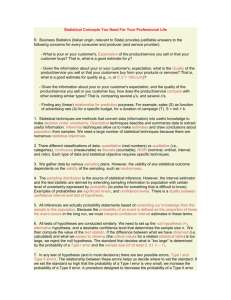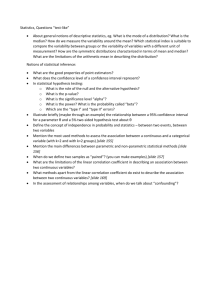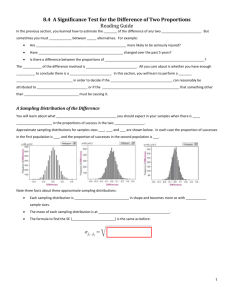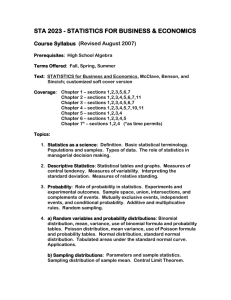it here
advertisement
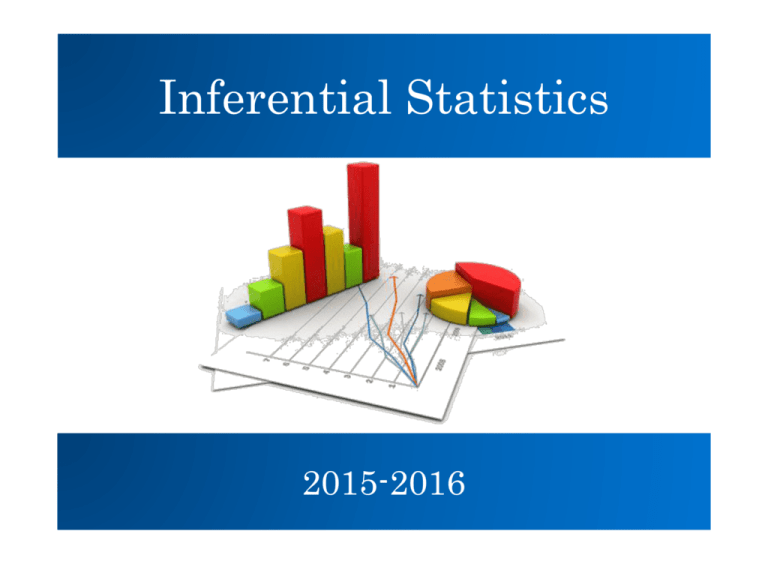
Ho me Inferential Statistics 2015-2016 Ho me Overview L.C. O.L. L.C. H.L. 1. 2. 1. 2. 3. 3. Sampling variability Confidence intervals for population proportion. Hypothesis testing using confidence intervals 4. 5. 6. 7. 8. Normal distribution Sampling variability Distribution of sample means Confidence interval for population mean Distribution of sample proportions Confidence interval for population proportion The margin of error Hypothesis testing using pvalues Ho me Inferential Statistics Leaving Cert. Ordinary Level Ho me Statistical Inference Ask a question Census Gather data Sample Analyse data Can we reliably use the results from a single sample to make conclusions about a population? Draw conclusions Ho me Inferences about proportions Ho me Sampling variability What proportion of students keep their mobile phone under their pillow at night? Ho me Sampling variability Make your own statement “The proportion of all students who keep their mobile phone under their pillow at night is _____” Sample 1 2 3 4 5 6 7 Statement Ho me Sampling variability • Different samples will yield different results (due to random nature of sampling) • How then can we use a single sample to draw conclusions about a population? Ho me Sampling variability Ho me Sampling variability How can we capture this uncertainty in our statement? “The proportion of all students who keep their mobile phone under their pillow at night is _____” The proportion of students who keep their mobile phone under their pillow at night is between 0.1 and 0.45? Ho me A confidence interval • How do we decide on this range if we have one sample only? • How confident can we be that this range captures the population proportion? Ho me The 95% confidence interval I can be 95% confident that the population proportion lies between sample − proportion 1 𝑛 & sample + proportion 1 𝑛 Ho me What does 95% confidence mean? Ho me The margin of error • 1 𝑛 is often referred to as the margin of error? • Why do you think this is? Ho me The margin of error • How could you make your margin of error small? • Why should depend on n? n 1 1 10 0.316 100 0.1 500 0.045 1000 0.032 2000 0.022 5000 0.014 n Ho me The margin of error • Why might you want to make your margin of error small? Ho me The power of statistics 4.6 million 1.36 billion Ho me Assessment of student understanding Ho me Assessment of student understanding Ho me A political party claims that it has the support of 24% of the electorate. In a sample of 1111 voters, 243 state that they support the party. Is there sufficient evidence to reject the party’s claim, at the 5% significance level? Step 1. State the null & alternative hypotheses 𝐻0 : 0.24 of the electorate support the party 𝐻𝐴 : The proportion of the electorate that support the party is not 0.24 𝐻𝐴 : 0.24 of the electorate do not support the party 𝐻0 : p=0.24 𝐻𝐴 : p≠0.24 intermediate step to help students with language Null Hypothesis Hypothesis tests Ho me Hypothesis tests Step 2. Build a 95% confidence interval for the population proportion. I am 95% confident that the population proportion lies 243 1 243 1 between − and + . 1111 1111 1111 1111 i.e. the 95% confidence interval for the population proportion is: 0.1887 ≤ 𝑝 ≤ 0.2487 Step 3. Make conclusion based on whether hypothesised proportion is inside or outside the confidence interval. Since 𝑝 = 0.24 is within the 95% confidence interval I fail to reject the null hypothesis. There is insufficient evidence to reject the party’s claim at the 5% significance level. Ho me Hypothesis tests Ho me Inferential Statistics Leaving Cert. Higher Level Ho me Statistical Inference Ask a question Census Gather data Sample Analyse data Can we reliably use the results from a single sample to make conclusions about a population? Draw conclusions Ho me Prior knowledge Ho me The Normal Distribution de Moivre Gauss Laplace 𝑥−𝜇 𝑧= 𝜎 Quételet Ho me The Normal Distribution The heights of Irish males is normally distributed with a mean of 176 cm and a standard deviation of 6.5 cm. 1. What proportion of Irish males have heights between 169.5 cm and 182.5 cm? 2. What proportion of Irish males have heights between 166.5 cm and 185.5 cm? 3. What proportion of Irish males have heights greater than 190 cm? 4. What proportion of Irish males have heights equal to 190 cm? 5. If I choose an Irish male at random, what is the probability he will have a height greater than 190 cm? 6. If I choose an Irish male at random, what is the probability he will have a height of 190 cm? Ho me Sampling variability • A good understanding of sampling variability lays the foundations for – confidence intervals – hypothesis testing • Sketching the distribution of the sample statistic is a key skill students should develop Ho me Inferences about means Ho me Sampling variability What is the mean schoolbag weight for Irish secondary-school students? Ho me Sampling variability Make your own statement “The mean schoolbag weight for all Irish post-primary students is _____” Sample 1 2 3 4 5 6 7 Statement Ho me Sampling variability • Sampling variability means we cannot equate the results from a single sample with those for a population. 𝜇≠𝑥 Ho me The distribution of sample means • In spite of this we can still use a single sample to make a valid statement about a population • To do so we need to understand all the possible means we can get when we choose a sample. Ho me The distribution of sample means • Different samples give different means but the distribution of sample means is normal (for large sample sizes). Ho me The distribution of sample means • The centre of the distribution (𝝁𝒙 ) is identical to the population centre (𝝁). Ho me The distribution of sample means • The distribution is more compact than the population. Ho me The distribution of sample means Why is the distribution of sample means more compact than the population? Ho me The distribution of sample means How does the spread of the distribution of sample means compare to the population? 𝟐. 𝟓𝟕 ≅𝟖 𝟎. 𝟑𝟐 𝝈 𝝈𝒙 = 𝒏 Ho me The 95% confidence interval • This means I can say with 95% confidence my 𝑥 value lies within 1.96 standard deviations of the centre of my distribution(𝜇𝑥 ). • This means I can also say with 95% confidence that the centre of my distribution(𝜇𝑥 ) lies within 1.96 standard deviations of my 𝑥 value. Ho me The 95% confidence interval I can say with 95% confidence that 𝑥 lies within 1.96𝜎𝑥 of 𝜇𝑥 . I can say with 95% confidence that 𝜇𝑥 lies within 1.96𝜎𝑥 of 𝑥. I can say with 95% confidence that 𝜇 lies within 1.96𝜎𝑥 of 𝑥. Ho me Constructing a 95% confidence interval 2.57 64 Use 𝜎 for building confidence interval if you know its value. Otherwise use s. 𝜇𝜇𝑥 • I can say with 95% confidence that 4.6 lies 2.57 within 1.96 of 𝜇 64 • I can say with 95% confidence that 𝜇 lies 2.57 within 1.96 of 4.6 2.57 2.57 64 4.6 − 1.96 64 ≤ 𝜇 ≤ 4.6 + 1.96 64 Ho me Constructing a 95% confidence interval 2.57 2.55 64 64 𝜇 4.6 − 1.96 2.55 64 ≤ 𝜇 ≤ 4.6 + 1.96 2.55 64 Ho me Assessment of student understanding Ho me Assessment of student understanding Ho me Summary • Due to sampling variability I cannot say 𝜇 = 𝑥. • Due to the normal shape of the distribution of sample means I can say with 95% confidence that 𝜇 lies within 1.96𝜎𝑥 of 𝑥. 𝜎 𝜎 𝑥 − 1.96 ≤ 𝜇 ≤ 𝑥 + 1.96 𝑛 𝑛 Ho me Inferences about proportions Ho me Sampling variability What proportion of students keep their mobile phone under their pillow at night? Ho me Sampling variability Make your own statement “The proportion of all students who keep their mobile phone under their pillow at night is _____” Sample 1 2 3 4 5 6 7 Statement Ho me Sampling variability • Sampling variability means we cannot equate the results from a single sample with those for a population. 𝑝≠𝑝 Ho me The distribution of sample proportions • In spite of this we can still use a single sample to make a valid statement about a population • To do so we need to understand all the possible proportions we can get when we choose a sample. Ho me The distribution of sample proportions • Different samples give different proportions but they all follow a normal distribution. The distribution of sample proportions • The centre of the distribution (𝝁𝒑 ) is identical to the population proportion (𝒑). Ho me The distribution of sample proportions • The standard deviation of the distribution is given by 𝜎𝑝 = 𝑝(1−𝑝) 𝑛 Ho me Ho me The 95% confidence interval • This means I can say with 95% confidence that my 𝑝 value lies within 1.96 standard deviations of the centre of the distribution. • This also means I can say with 95% confidence that the centre of the distribution lies within 1.96 standard deviations of my 𝑝 value. Ho me The 95% confidence interval I can say with 95% confidence that 𝑝 lies within 1.96𝜎𝑝 of 𝜇𝑝 . I can say with 95% confidence that 𝜇𝑝 lies within 1.96𝜎𝑝 of 𝑝. I can say with 95% confidence that 𝑝 lies within 1.96𝜎𝑝 of 𝑝. Ho me Constructing a 95% confidence interval (0.2)(0.8) 30 Use 𝑝 for building confidence interval if you know its value. Otherwise use 𝑝. 𝜇𝑝𝑝 • I can say with 95% confidence that 0.2 lies within 1.96 (0.2)(0.8) 30 of 𝑝. • I can say with 95% confidence that 𝑝 lies within 1.96 (0.2)(0.8) 30 of 0.2. Ho me Constructing a 95% confidence interval The 95% confidence interval for the population proportion is: 0.2 − 1.96 0.2 0.8 (0.2)(0.8) ≤ 𝑝 ≤ 0.2 + 1.96 30 30 Ho me The margin of error • 1.96 𝑝 1−𝑝 𝑛 ≤ 1 𝑛 Ho me Assessment of student understanding Ho me Means Proportions 𝝈𝒙 = 𝝈 𝒏 𝜇𝑥 = 𝜇 I can say with 95% confidence that 𝜇 lies within 1.96𝜎𝑥 of my 𝑥 value. 𝝈𝒑 = 𝒑 𝟏−𝒑 𝒏 𝜇𝑝 = 𝑝 I can say with 95% confidence that 𝑝 lies within 1.96𝜎𝑝 of my 𝑝 value. Formulae Summary Ho me Hypothesis testing using p-values Hypothesis tests are based on understanding the properties of the distribution of the sample means (or sample proportions). Ho me Hypothesis testing using p-values The mean amount of time spent daily on homework & study by Leaving Cert. students in 2013-2014 was 5.4 hours with a standard deviation of 1.8 hours. A guidance counsellor surveys 50 Leaving Cert. students in his school during 2014-2015 and finds that the mean amount of time spent on homework is 5.1 hours. By carrying out a hypothesis test at the 5% significance level, determine if the results for 2014-2015 are consistent with those for 20132014. Ho me Hypothesis testing using p-values H0: The mean amount of time spent studying by Leaving Cert. students in 2014-2015 is 5.4 hours. H1: The mean amount of time spent studying by Leaving Cert. students in 2014-2015 is not 5.4 hours. Ho me The language of a hypothesis test • The term “null hypothesis” comes from the idea of a “null effect” or “no change” so 𝐻0 should be stated as such i.e. as a statement of no change • H0: The mean amount of time spent studying by Leaving Cert. students in 2014-2015 is 5.4 hours The mean amount of time spent daily on homework & study by Leaving Cert. students in 2013-2014 was 5.4 hours with a standard deviation of 1.8 hours. A guidance counsellor surveys 50 Leaving Cert. students in his school during 2014-2015 and finds that the mean amount of time spent on homework is 5.1 hours. Ho me Hypothesis testing using p-values If H0 is true we’d expect the distribution of sample means to be: 𝜎𝑥 = 𝜇𝑥 = 5.4 1.8 50 Ho me Hypothesis testing using p-values If H0 is true how likely am I to get a sample mean of 5.1 due to variability? Because of the hypothesis I need to determine how likely I am to get a sample mean of 5.1 or 5.7? Because of the properties of the normal distribution I need to determine how likely I am to get a sample mean of less than (or equal to) 5.1 or greater than (or equal to) 5.7. Ho me Hypothesis testing using p-values Use z-scores to determine this probability 5.4 − 5.1 𝑧 = = 1.18 1.8 50 𝑃 𝑧 ≥ 1.18 = 2(1 − 0.8810) 𝑃 𝑧 ≥ 1.18 =0.238 Ho me Hypothesis testing using p-values • If this probability is really small, this implies that the sampling distribution is unlikely to be centred on the hypothesised value (assuming the given standard deviation) • How small is small? – 5% – 0.05 Ho me What does the p-value mean? • probability of getting results at least as unusual as the observed mean given that the null hypothesis is true. What does the level of significance mean? 1. The probability boundary around which you either reject or fail to reject the null hypothesis. If p > significance level, fail to reject the null hypothesis. If p < significance level, reject the null hypothesis. 2. The probability of rejecting the null hypothesis even if it’s true. Ho me Ho me The syllabus Assessing student understanding Ho me The syllabus Assessing student understanding Ho me The syllabus Alternative approach using p values Ho me Use 𝑝 if known. Otherwise use 𝑝. The syllabus Alternative approach using p values Ho me Assessing student understanding Use 𝜎 if known. Otherwise use s. Ho me Assessing student understanding Ho me Assessing student understanding Ho me Assessing student understanding Ho me Summary • Hypothesis testing is built on a good understanding of – z-scores – the distribution of the sample statistic

